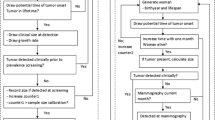Abstract
A model of breast cancer screening was developed, in which the processes of tumour origination and growth, detection of tumours at screening, presentation of women with cancers to their GP, and of survival after diagnosis were modelled parametrically. The model was fitted to data from the North‐West of the UK, for 413 women who screened positive, and for 761 women who developed interval cancers. Model validation comprised verification that the final model fitted the data adequately, together with the comparison of model predictions with findings by other workers.
The mathematical model was used to assess different screening policies, and to ask “what if” questions. Taking the cost of breast cancer to be the sum of the cost of screening and the cost of PYLL (person years of life lost due to cancer), the optimal screening policy was calculated. The costs of the current policy and of other possible screening policies were found, together with their effects on life lost and on mortality. The tentative conclusion was that if monies can be found to extend the screening programme, for example to carry out one more screen per woman, most benefit would be obtained by reducing the start age of screening by 3 years.
Similar content being viewed by others
References
N.E. Day and S.D. Walter, Simplified models of screening for chronic disease: estimation procedures from mass screening programmes, Biometrics 40 (1984) 1-14.
S.W. Duffy, H.-H. Chen, L. Tabar and N.E. Day, Estimation of mean sojourn time in breast cancer screening using a Markov chain model of both entry to and exit from the preclinical detectable phase, Statistics in Medicine 14 (1995) 1531-1543.
T. Hopkins and C. Phillips, Numerical Methods in Practice Using the NAG Library (Addison-Wesley, Wokingham, 1988).
J.T.M. Jansen and J. Zoetelief, MBS: a model for risk benefit analysis of breast cancer screening, British Journal of Radiology 68 (1995) 141-149.
A.E. Johnson and J. Shekdar, Interval cancers in the National Health Service breast screening programme, British Journal of Radiology 68 (1995) 862-869.
G.J. Oortmarssen, J.D.F. Habbema, P.J. Maas, H.J. Koning, H.J.A. Collette, A.L.M. Verbeek, A.T. Geerts and K.T.N. Lubbe, A model for breast cancer screening, Cancer 66 (1990) 1601-1612.
W.H. Press, B.P. Flannery, S.A. Teukolsky and W.T. Vettering, Numerical Recipes, 2nd ed. (Cambridge University Press, Cambridge, 1992).
M. Schwartz, An analysis of the benefits of serial screening for breast cancer based upon a mathematical model of the disease, Cancer 41 (1978) 1550-1564.
M. Zelen and M. Feinleib, On the theory of screening for chronic diseases, Biometrika 56 (1969) 601-614.
Author information
Authors and Affiliations
Rights and permissions
About this article
Cite this article
Baker, R.D. Use of a mathematical model to evaluate breast cancer screening policy. Health Care Management Science 1, 103–113 (1998). https://doi.org/10.1023/A:1019046619402
Issue Date:
DOI: https://doi.org/10.1023/A:1019046619402




